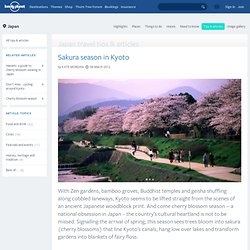

Don't miss...cycling around Kyoto. In this extract from the Lonely Planet guide Discover Japan, Taga Kazuo, founder of Kyoto Cycling Tour Project and author, tell you the sights to hit on a two-wheeled tour of this culturally rich city.

A bicycle is the best and fastest way to get around Kyoto: it’s economical and you don’t have to worry about traffic jams. Most of Kyoto’s sights are located in a compact area and there are no big hills. Kyoto is easy to navigate and a bicycle lets you get to the heart of the city. Nanzen-ji Temple Zen is perhaps the most famous of all schools of Buddhism and this is a great example of a classic Zen temple. Tetsugaku-No-Michi (Path of Philosophy) The 20th-century philosopher Nishida Kitarō used this fine canal-side path for his daily walking meditation.
Sakura season in Kyoto. With Zen gardens, bamboo groves, Buddhist temples and geisha shuffling along cobbled laneways, Kyoto seems to be lifted straight from the scenes of an ancient Japanese woodblock print.

And come cherry blossom season -- a national obsession in Japan – the country’s cultural heartland is not to be missed. Signalling the arrival of spring, this season sees trees bloom into sakura (cherry blossoms) that line Kyoto’s canals, hang low over lakes and transform gardens into blankets of fairy floss. Cherry blossom philosophy The cherry blossom is richly symbolic within Japan – it is depicted on the 100 yen coin and was used as a symbol to stoke nationalism during World War II. Many Japanese believe that the blooming of the trees symbolises the transience of life and is an annual reminder that time is precious.
Hanami. Top 10 things to Do in Japan. Scott Norvell: 9 Rules Westerners Should Remember When Visiting Japan. In many ways -- to Western eyes anyway -- Japan is as baffling as Bill Murray's facial expressions made it seem in Sofia Coppola's brilliant 2003 Oscar-winner "Lost in Translation.

" The sea of black suits streaming down Tokyo's sidewalks. The young female barkers dressed like schoolgirls outside Akihabara's maid cafes. Multi-story towers of pachinko machines or computer games emitting ungodly noises. It truly is overwhelming. It's outwardly disorderly in many ways, but underneath is anything but. I give you, then, nine things that every traveler to Japan should know before they get on a plane. 1. 2. It's a major digression to smoke while walking down Tokyo's crowded sidewalks. But, curiously, people still smoke prevalently indoors. 3. 4. 5. 6.
Il Giappone è Zen! - JNTO Ente Nazionale del Turismo Giapponese. Zen.

Ed ecco evocati la calma, il vuoto, la pace interiore, ma anche immagini più tangibili come i giardini di pietra o di muschio, le ampie stanze dei tatami, o ancora l’arte del tè. Immergetevi in un bagno! - JNTO Ente Nazionale del Turismo Giapponese. Una delle tradizioni più gradevoli del Giappone è senza dubbio quella di immergersi nelle vasche, soprattutto quando si tratta di onsen, sorgenti d’acqua calda di origine vulcanica.

In qualunque regione ci si trovi, ci sono sempre degli onsen vicine, e una delle attività preferite dei giapponesi è proprio quella di recarvisi durante il fine settimana o per qualche giorno per approfittare delle proprietà minerali di queste sorgenti. Passeggiata di tre - JNTO Ente Nazionale del Turismo Giapponese. Senza dubbio conoscete le celeberrime incisioni de "Le 36 vedute del monte Fuji" di Hokusai o "Le 53 vedute del Tokaido" di Hiroshige.

Ma sapete quello che questo gusto per l’enumerazione dei siti più famosi è assai radicato nella cultura giapponese? In realtà, vi sono generalmente tre siti o avvenimenti irrinunciabili che bisogna aver visitato almeno una volta nella vita. Quest’infatuazione ebbe inizio nel XVII secolo con le "Tre vedute" o Sankei, elenco compilato dal letterato Hayashi Razan. List of Volunteer Guide. List of Volunteer Guide. Nara Travel Guide.
Online Guide for Exploring Kyoto on Bicycle. Travel Guide <Official>///Leisure. Kyoto Travel: Access, Orientation and Transportation. How to travel between Kyoto and Tokyo How to travel between Kyoto and Kansai Airport.

Timetable and Route Search in Japan. How To Make Miso Soup Recipe (Japanese) Miso Soup Recipe.

This delicious and nutritious soup is an essential element to Japanese cuisine. Follow Reiko's simple steps in preparing this famous dish. Delight in our Miso Soup recipe. View Ingredients In: 5 g dried seaweed (wakame)120 g fresh soft tofu or long life silken tofu400 ml dashi OR 400 ml (14.1 fl oz) of water and ½ tsp powdered dashi1 1/2 miso paste2 medium spring onions1 measuring jug1 saucepan1 small bowl1 cup 1 tablespoon1 teaspoon1 sharp knife1 chopping board You Will Need Step 1: Heat the Dashi Pour the dashi into a large sauce pan, place it on the hob and turn the heat up high. Step 2: Soak the wakame Meanwhile put the 5 grams or 0.2 oz of dried wakame in a small bowl, and add enough water to cover it well. Step 3: Melt the miso Put one and a half tablespoons of miso paste in a cup, add enough spoonfuls of dashi from the pan to melt it. Viaggio Giappone.